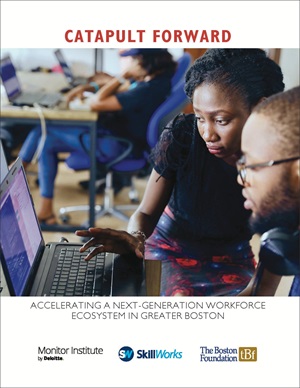
Catapult Forward:
Table of Contents
- Context
- Leading Practices for Next-Gen Workforce Providers
- Catapult Competency 1: Being Market Responsive
- Catapult Competency 2: Focusing on Good Jobs
- Catapult Competency 3: Lifting Untapped Talent
- Catapult Competency 4: Investing in Organizational Capacity
- Gaps and Opportunities in Greater Boston's Workforce Development Ecosystem
- Appendices
Report Team
AUTHORS
Tracie Neuhaus
Kaitlin Terry Canver
Heena Khoja
CONTRIBUTORS
Kaitlyn Bean
Nancy Snyder
EDITOR
Sandy Kendall
DESIGNER
Kate Canfield
Executive Summary
Background
Today’s tight labor market, anticipated Baby Boomer retirements in the coming years, and growth of high demand and skilled jobs are contributing to a never before seen tension between the demand to fill jobs and the lack of supply ready to fill those jobs.
Unemployment in Massachusetts is at a historic low of 2.9% (lower than the national unemployment rate of 3.7%). In fact, Boston’s economy has been booming for a number of years, indicating consistently strong demand for labor despite broader economic fluctuations. In the current labor market, the need for workers has only gotten stronger, making it especially difficult for many employers in the region to meet their needs.
But with great challenge often comes great opportunity. In the words of Boston Foundation President and CEO Paul Grogan, “A tight labor market is a terrible thing to waste.” Together with SkillWorks, the Boston Foundation launched Project Catapult to seize this moment of opportunity for both today and tomorrow—to invest in sustainable workforce solutions that can fill Greater Boston’s labor market needs, address growing income inequality, and fuel regional growth for the long term.
Critical to this are organizations that the Boston Foundation calls “Next-Generation Workforce Providers”—a type of workforce organization that seeks to expand job and career opportunities for lower-income individuals while also being responsive to employers’ talent needs. Not only does investing in “Next-Gen” Workforce Providers today accelerate the number of new participants in the labor force in the short term (a significant opportunity for the region considering how tight labor market is); it also establishes structures designed to serve the region’s workers and employers in the long term, including in times of higher unemployment.
Objectives and Approach
This report examines the role of Next-Gen Workforce Providers in the Greater Boston workforce ecosystem by looking at the work of specific organizations identified by the Boston Foundation. It identifies leading practices to help Next-Gen Workforce Providers and other organizations learn from each other; catalogues who’s doing what to support greater coordination and collaboration; and highlights where gaps remain in the overall workforce and employment ecosystem.
Our findings are predominantly based on primary research: Over the course of three months, Monitor Institute by Deloitte worked with the Next-Gen Workforce Providers identified by the Boston Foundation as well as seven employers and 13 jobseekers to articulate leading practices in Greater Boston’s workforce development landscape and understand critical gaps and opportunities. The specific workforce providers were highlighted for demonstrating the core competencies of a Next-Gen approach, as defined by Project Catapult: being market responsive, focusing on “good jobs” (i.e., those that provide living wages, benefits, growth opportunities, etc.), lifting untapped talent (i.e., helping non-traditional talent pools access job opportunities), and investing in organizational capacity. Examples and quotes mentioned herein come from interviews, and we did not conduct a thorough analysis of other data sources. Given the focused scope of our research, we welcome and invite others to build on this work. More information about the organizations and people involved in our research can be found in the Appendix.
What We Learned
Next-Gen Workforce Providers play a critical role in the Greater Boston ecosystem. Jobseekers turn to them for training, support, and community, and employers rely on them to help find and train qualified candidates and upskill incumbent workers.
Today, many Next-Gen Workforce Providers are primarily trying to “build the supply” of talent, serving many distinct populations in Greater Boston through targeted approaches, focusing on increasing the quality and quantity of available workers. The “untapped” workforce is oftentimes unemployed or underemployed because its members face barriers to employment such as low education levels, limited English language abilities, or criminal records, so tailored programming and wraparound supports that empower specific populations have become even more critical. And while there may be many organizations competing for similar public or philanthropic funding, there is plenty of room for them all to do their work as the need among jobseekers is large and organizations are serving different people in distinct ways. Still, there’s ample opportunity for greater coordination, cross-learning, and outcomes-sharing across workforce providers.
To maximize impact, Next-Gen Workforce Providers in Greater Boston can also increase their focus on “building demand,” or adopting an employer-centered lens in their work and working to shift employer mindsets, particularly around how they source, retain, and advance talent. Beyond working with employers to place jobseekers, workforce providers can engage employers more proactively to understand their needs and design training around these needs, as well as help employers evaluate and evolve their hiring, advancement, and retention practices (particularly for untapped talent). At the same time, employers can take a more active position as partners and co-investors in the workforce development ecosystem, recognizing it as a business imperative rather than a charitable contribution.
The good news is that many Next-Gen Workforce Providers are already adopting these new ways of working in partnership with jobseekers and the region’s leading businesses. In the table below, we briefly summarize the leading “next-gen” practices (as they relate to the Boston Foundation’s four-competency framework) that we observed across the workforce providers we worked with; more detailed descriptions and examples can be found in the full report.
While workforce providers are key players in the Greater Boston workforce development ecosystem, many other parties have a role to play to increase the effectiveness and cohesion of the system. In fact, several of our interviewees observed that workforce development in Greater Boston is so fragmented that there is no singular ecosystem. Employers, public sector actors, and education institutions, in particular, can benefit from greater coordination with one another and with workforce providers to better serve jobseekers’ needs and fill talent gaps for employers. As Next-Gen Workforce Provider Year Up put it, “We need to close the opportunity divide, but that doesn’t mean [a single workforce provider] has to do all the work. There are things we can’t do if we try to do it all alone.” (See: Gaps and Opportunities in Greater Boston’s Workforce Development Ecosystem for more detail on the roles other parties can play.)
We hope that all players in Greater Boston’s workforce development system can learn from these leading practices and from other observations outlined in this report to work as individual organizations and a collective system to better serve the needs of jobseekers and employers, help reduce economic inequality in our region, and boost economic growth.
Table 1: Summary of Leading Practices
|
LEADING PRACTICE |
DESCRIPTION |
|
Competency: Being Market Responsive |
|
|
A. Fostering Deep and Strategic Partnerships with Employers and/or Industries |
Shift from purely transactional interactions to deep and strategic partnerships with employer and/or industries to help them fill business needs; includes creating employer consortia, hiring dedicated employer liaisons, and presenting high-quality job candidates. |
|
B. Being Nimble in Response to Regional and Economic Changes |
Conduct sensing activities regularly to understand how the market is changing and adjust programming and partnerships to fill these demands. |
|
C. Creating Talent Supplier Agreements, Possibly Including Customized Employer Training |
Develop internship and/or full-time talent supplier agreements with employers, such that employers commit to dedicating a number of openings for the workforce provider’s program participants, and work with employers to develop customized fee-for-service trainings. |
|
Competency: Focusing on Good Jobs |
|
|
D. Defining and Identifying Good Jobs |
Define “good jobs” based on the needs of the target population and tailor programming to help workers find jobs that meet these needs. |
|
E. Leveraging Trusted Employer Relationships to Support Untapped Talent in the Long Term |
Consult with employer partners to help ensure their hiring, retention, and advancement practices support program participants and other untapped talent to be successful in their roles, while enhancing employers’ operational efficiencies and overall talent strategy. |
|
F. Providing Training and Pathways for Advancement and Retention (Not Just Placement) |
Support workers in their career progression by providing opportunities for upskilling (e.g., incumbent worker training), paid for by employers in order to help them retain and advance their talent. |
|
Competency: Lifting Untapped Talent |
|
|
G. Offering Tailored Programming to Target Population |
Design trainings with tailored content, appropriate pedagogical approaches, language instruction (as needed), and other supports that address potential barriers to employment and to help make jobseekers ready for work. |
|
H. Providing Holistic, Wraparound Supports |
Recognize the holistic needs of program participants and offer wraparound supports (e.g. training stipends, transportation assistance, coaching) as needed. |
|
I. Offering Laddered Work Experience via Social Enterprise Model |
Offer supported work experience by running a business or social enterprise in-house, serving as an employer while providing a structured training environment. |
|
J. Supporting and Leveraging Alumni |
Actively offer ways for program alumni to stay connected with, represent, and enhance the program; maintain alumni networks to support the ongoing professional development and advancement of graduates. |
|
Competency: Investing in Organizational Capacity |
|
|
K. Cultivating Intentional Partnerships with Other Providers |
Build structured, collaborative partnerships to deliver a broader range of services to better serve the holistic needs of jobseekers and employers. |
|
L. Encouraging Organizational Learning and Continuous Improvement |
Maintain a mindset of and invest in constantly aspiring to do better, being willing to evolve, integrating participant feedback, and building the internal capabilities to support continuous learning and adaptation. |
|
M. Leveraging Technology and Data Strategically |
Use technology and data to support innovative program delivery and indicate program quality to jobseekers and employers. |
|
N. Exploring Innovative Funding Models |
Consider opportunities to earn revenue (e.g., running social enterprises, providing paid services to employers) or tap into unconventional funding sources to boost financial sustainability. |


